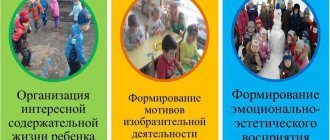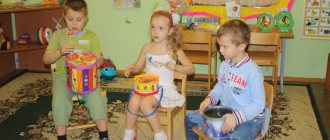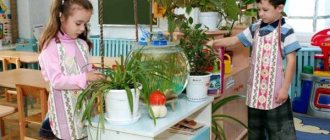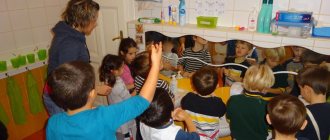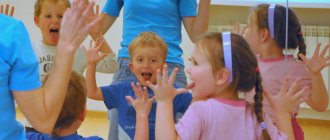All children in the world are united by a love of games.
Play is a natural need for a child, since it is in the form of play that children learn about the world, understand how it works, and consciously comprehend the experience gained.
Play is important not just as a source of joy and good mood, it develops the brain, imagination, creativity, vocabulary, social skills, the ability to learn and perceive more complex information.
How do 6-7 year old children develop?
At this age, the baby’s thinking abilities enter a new, better stage of development.
By age 6, most children:
- master reading, writing, counting to 20;
- understand the simplest time intervals;
- focus longer on one solution to one logical problem;
- their reasoning becomes more meaningful;
- understand information better by listening.
What games are useful at this age?
For a preschooler, different forms of games will be useful.
Psychologists recommend involving children in the following game formats:
- child-initiated play;
- play initiated by an adult;
- a traditional game when both a child and an adult can take the initiative.
From the point of view of benefits, the most significant games are those offered by adults, since in this case the child finds himself in a learning situation, gets acquainted with new words, concepts and can make this situation manageable.
As for choosing a specific game format, it all depends on the situation. For the street, outdoor games are selected that contain an element of sports. At home, you can play board games or role-playing games, or assemble a construction set.
1. Outdoor games develop coordination, strength, endurance, and reaction speed. At the age of 6-7 years, the game lasts about half an hour.
2. Board games help brighten up your leisure time when the weather is bad outside. With the help of cubes, puzzles, figures, cards, the child improves his skills - logic, spatial thinking, social interaction, speech, concentration, will.
There are a huge number of board games - walkers, puzzles, cubes, mosaics, construction sets, flashcards, strategies.
3. Educational games - in this case we are talking about the targeted development of a specific skill or ability, for example, speech, gross motor skills, intelligence, imagination.
The use of such games prepares fertile ground for the further development of the child’s creative abilities and talents. The training program is structured from simple to complex, but the conditions of each task should be slightly ahead of the child’s developmental level.
Mathematics
Children of senior preschool age should already be able to do a lot by the age of seven. Their list of knowledge includes:
- ability to solve simple problems and puzzles;
- know what it means to add or subtract, and distinguish between the signs “+”, “–”, “=”, “<” and “>”;
- be able to count to 10, performing operations with sets, count both forward and backward;
- make comparisons in terms of “less”, “more”, equal or unequal;
- understand how to answer correctly when the question begins with the words “how much, which, which number”;
- distinguish shapes - round, square, triangular and rectangular, and divide them into parts (semicircle, etc.).
If your baby doesn’t yet know how to do any of the above, that’s okay. This can be corrected with special training. The main thing is to do them regularly, and the child will quickly master what he did not have time to learn before.
Parts of the whole
The child must understand that something whole can consist of several parts. This is best explained using geometric figures. That is why we chose the following tasks:
- Print out cards with several geometric shapes of different shapes. Then the child must watch carefully. For example, two triangles can be used to form a square or rectangle, semicircles form a circle, etc.
- Math puzzles. With their help, the child will not only learn to select the necessary parts, but also understand their spatial position. For example, if a piece of a puzzle is turned the other way, even if it is correct, the piece will not be suitable for forming the whole.
- Figures of different shapes. This is a three-dimensional example of how to put parts together into a whole.
The beauty of these activities is that you don't have to buy anything separately. To practice with pictures, you can simply print and cut them out. Puzzles can also be printed, but on thicker paper.
Counting to 10
Seven-year-olds should already be able to count to ten and try to perform simple mathematical operations with numbers. If the child is still lost, special tasks will help him better understand the material:
- Math puzzles. The essence of the game is that to get the correct picture you need to assemble the puzzle pieces in order. That is, from 1 to 10. You cannot rearrange the numbers, but you can start counting not from one, but from 10. This will help the child learn to count both in the correct order and vice versa.
- Counting books with coloring pictures. The game format of counting allows it to be learned even by children who are not particularly inclined towards exact sciences and studies in general. Under each number there is a color, but to recognize it, you need to be able to count and perform simple mathematical operations.
- Copy-numbers. Children will learn to not only count correctly, but also write each number. To do this, it is best to use the saying “Learning and growing. Numbers from 1 to 30”, where the child will be able to print the necessary symbols by following the dotted line.
Today there are many other interesting tasks, so don’t stop at the ones listed. And don’t forget to gradually complicate the tasks for your child.
Count to 20
The next step in teaching a young mathematician is to teach him to count to 20. The transition to tens sometimes becomes real stress for a child, but if everything is organized correctly, you can quickly master counting, at least to 20. The following problems will help with this:
- Connecting even and odd numbers from 1 to 20. Here children learn by connecting even (2,4,6,8, etc.) numbers with each other, and by the same analogy, odd (1,3,5, etc. .). This way, the kids will learn not only to count, but also to do it at random. And naturally, they will understand which numbers are even and which are not. All tasks make sense, because by connecting certain numbers we build a path along which the cartoon character seems to have to go. The child finds this interesting.
- Table with numbers, some missing. The task contains several sheets that are intended for children with different levels of knowledge. For example, on the first sheet you can make a table counting up to 10, on the second - up to 20, on the next - up to 50 and up to 100. And so with one tool you can learn the first hundred. In addition, the child will be able to better remember how these numbers are written, because he must enter them.
- Cards with numbers. Each number should be on a separate card, and it is desirable that there is something else on the picture. For example, if the number 19 is drawn, the picture may show a hen with 18 chicks. That is, the number of items should be exactly as much as the indicated number indicates. This way the baby will master not only numbers, but also the concept of quantity.
You should not leave your child alone with these tasks - help him.
Counting to 100
Today we’ll look at one, but universal, way to teach a child to count within a hundred. Moreover, it is much more effective than various coloring books or copybooks, and all you need for this is 10 boxes of matches. But it is advisable to cover them with multi-colored paper. You will also need paper squares with numbers from 1 to 100 written on them.
Show your child what is required of him. Take one match and find a square that says “One” on one side and “1” on the other. The baby must repeat your action up to 10.
Having collected 10 matches, you need to take a box and put the selected matches there. The child needs to be explained that the number of matches collected in the box is ten. One box – 1 ten, two boxes – 2 tens, etc. since every new 10 matches must be hidden in a new box.
Next, explain to your child that tens are called “Twenty.” That's what they were called in ancient times. You can even write this on the box.
Take one match and place it on the box. It turns out to be “one in twenty”, but is pronounced as “eleven”. For clarity, you need to put a card with this number next to it. Further by analogy - “twenty-twenty”, “three-twenty” and so on until 19.
When 10 new matches are collected, they again need to be hidden in a new box. That is, another “twenty”. We get two boxes, that is, “twenty.”
Place one match next to the two “twenty” boxes. We will get two “twenty” and one match, that is, “twenty-one.” On the card next to it show how it is written. And so continue until 40.
Now is the crucial moment, since the word “forty” has nothing to do with the number “four”. A small brain accustomed to the simple analogy shown above may become confused because the number is supposed to sound like “four.” It is not interesting for a child to delve into the linguistic jungle, but listening to a fairy tale is the opposite. For example:
Once upon a time there lived three faithful friends - Twenty, Thirty and Fourty. Twenty was soft and fluffy, Thirty resembled a gray pebble, and Four sparkled like glass in the sun. When the guys wanted to take a walk, a magpie saw them. Since these birds are very fond of everything shiny, the magpie grabbed Fourty and dragged her to her nest. Since then, his friends have been saying everywhere that their companion now lives with the forty. And they do this so often that everyone around them began to call Fourty “Forty.”
If everything then goes like clockwork, then when you reach the number 90, a problem similar to the number 40 arises again. Ninety can be called that because nine tens so want to become a hundred that they even call themselves “nine-hundred.” If you add another ten to 90, it becomes a hundred.
Learning shapes
Playing with geometric shapes develops the baby. To study them, you can use the educational set “Form. Color. Size". Cards with pictures of geometric shapes of different colors are also used:
- The child receives cards that show from one to five figures. He must arrange them in ascending order.
- Find the same shapes on the cards, name them and what color they are.
- Lay out the cards and let the child list all the figures that are drawn there. Moreover, say what kind of figure is the first, second, third, etc.
- You can complicate the task if you ask the child to name the figure, for example, between a red square and a green triangle.
You can use other equipment. Even household items. For example, the closet is rectangular, the ball is round, mother’s perfume is triangular in shape, etc.
Comparison
At the age of six, a child must understand what more or less is, that is, compare mathematical concepts. A child learns best through visual examples.
That is why you can take cookies or candies and put them in two piles, making one a little larger in advance. The child must count the number of items in one and the other pile and say which one is larger. Ideally, it would be nice if he said how much bigger it is.
Games 30. Plant
First of all, you need to make a plant - a tree, a flower - from any available materials. Then the child composes a fairy tale about him. The main thing is that in the story the child describes in detail how the plant feels - is it comfortable or is something bothering it.
Through these metaphors, an adult can understand what is bothering the child. If there is a cause for concern, ask your child what you can do to help the plant - build a fence, call a fairy, plant other trees. This way the baby will use the example of a fairy tale to cope with his anxieties.
Games 31. Face games
In children who have suffered some unpleasant events in life, a frozen mask may appear on their face and emotions disappear. You can motivate your child in several ways - invite him to play tricks, make funny faces with him, or organize a home theater.
Games 32. Simple holidays
Allow your baby to feel the holiday in your life as often as possible. Try to turn every simple event into something bright and unusual. For example, the festival of making the bed, washing, the festival of lunch. Be sure to record any of your child’s achievements, write them down or draw them - this motivates and builds confidence in yourself and your abilities.
Games 33. Color therapy
If your child often returns to unpleasant events in the past, focus his attention on the current day, for example, come up with a specific color for each day of the week and try to stick to it. For example, let Monday be blue - pick up such clothes, look for blue objects around.
Games 34. Schedule
To stabilize a child’s condition after a stressful situation, it is necessary to structure his daily routine, draw up a schedule, and decorate it. The kid must monitor its implementation. On the one hand, it teaches discipline, and on the other, it distracts from unpleasant thoughts.
Advice! Anxious children prone to stress intuitively choose outdoor games where they need to jump. This helps relieve tension and feel supported. Create an area for your child where he can jump safely and happily.
Conflict situations sometimes occur between children, and here play becomes critically important, since with its help the child relieves stress and relaxes . Of course, games should be appropriate for the child’s age and development, be diverse and useful. This is what we will talk about in our material.
Free activities and lessons to prepare for school
Svetlana Orochko
Svetlana Orochko is the author of her own course on teaching preschoolers and primary school students, the creator of the “Firefly” preschool education center, a primary school teacher, and a preschool education teacher. She provides free classes on her YouTube channel, Svetlana, such as:
- We teach children to read.
- Fun geometry.
- Composition of numbers.
- Studying numbers.
- Getting ready for school.
- Developing memory.
- We make a word from syllables.
There are also video lessons for parents. Before each lesson, Svetlana Orochko gives explanations, where she suggests materials that need to be worked through together with the child, provides useful information about the school (for example: how to choose a primary school teacher).
More details
KaraDeRo
The YouTube channel Karadero was founded by primary school teacher Elena Vasilievna Rybalchenko. It contains informative and educational videos that will help you prepare for school, show you how to correct your handwriting, and gain new skills. The following educational videos are offered for children:
- I'm learning to count.
- Alphabet with a mouse.
- English alphabet, letters.
- Beautiful handwriting.
- How to teach how to write numbers beautifully.
- Speech therapy games.
- Mathematics for children 4-7 years old.
- Paid online courses to prepare for school
More details
Where to find time to play with your child
This question is asked by many parents, since modern moms and dads are busy people who have a lot of household responsibilities, work, of course, and a natural desire to take time for themselves and relax. Due to the fact that there is not enough time to spend with the baby, parents often worry and worry. Psychologists assure that you can find time to communicate with your child if you follow simple tips.
Tip 1 – play with your child and mind your own business at the same time.
Games that do not require special training or additional items can be played in the kitchen, bathroom, or on the street. If you don’t feel like playing, involve your child in homework, do something together, for example, make pizza, or just let your child help you.
The main thing is to talk to the child more, explain, praise and support.
Tip 2 – use any free minute.
Transport, queues, the road to somewhere - this time can be used profitably. Tell your child about natural phenomena, make riddles, compose fairy tales, play counting and words.
Tip 3 – games and activities should become a habit.
Of course, we are not talking about classes for an hour or two. Make it a rule to work with your child every day for 15-20 minutes; this will be quite enough for a child aged 6-7 years. For example, read a book to your child before bed.
Tip 4 – try to create a nurturing environment at home.
Use posters, manuals, cards, magnetic games. The more educational objects there are around a child, the faster he will remember information. Please note that developmental aids should be bright and colorful.
Tip 5 – find company for your child.
If this is the case and you cannot play with your baby, try to find children for him with whom he can spend his time.
English language
Surely you know that the earlier a child starts learning English, the greater the chance that he will actually learn it. The age of six is just a good start for learning a foreign language. Moreover, the baby already has a good vocabulary in his native language. This reduces the likelihood that he will begin to confuse words, creating a language mix.
But you need to approach learning responsibly, preparing the appropriate material:
- Alphabet cards. First, with the help of cards or a notebook “Learning to write lowercase letters of the English alphabet,” the child will learn the letters, learn to write and pronounce them. They can then be used to form simple words.
- Pictures for children with animals. They depict domestic and wild animals, birds and fish. The same pictures can be found depicting pieces of furniture, clothing, household items, transport, etc.
- Pictures with several variants of words describing what is happening on them. The child must choose the correct answer by placing a cross or a tick next to it.
These games will not only expand your vocabulary, but also help develop logical thinking. And to improve pronunciation, you can learn songs in English with your child, organizing entire performances, preparing costumes, simultaneously trying to describe them in English, etc. Children find this creative process very interesting.
Intelligence of a child aged 6-7 years
At this age, children have already formed personalities and have their own views on the world around them and what is happening in it. The child understands his position both in the children's team and among adults, and accordingly builds a line of behavior and forms a certain attitude towards the people who surround him.
The level of emotional development in children 6-7 years old is also quite high. They show sympathy , empathize, feel the mood of other people, and offer help.
- We are talking about children who are almost first graders, they can control their mood, follow the instructions and requests of adults, and take part in group and individual activities.
Advice! Since children 6-7 years old easily navigate circumstances, parents can give their child the basics of personal safety and teach them to find a way out of difficult situations.
2. At 6-7 years old, children show an active interest in new knowledge, since at this age the memory capacity increases, the child’s attention becomes more concentrated, and the vocabulary expands (up to 6 thousand words).
3. Parents need to continue classes on the development of children’s speech, familiarize children with the structure of language, in addition, develop fine motor skills, logic, and the ability to systematize objects by characteristics.
Types of developmental activities in the preparatory group
The implementation of development tasks according to the guidelines of the Federal State Educational Standard (FSES) accompanies the entire educational process in kindergarten, but is most pronounced when organizing educational activities. The list of disciplines is expanding in comparison with the senior group:
- mathematics (2 times a week);
- speech development (once a week);
- literacy training (once a week);
- physical education (3 times a week, in some kindergartens one of the three classes is allocated for sports games, and separately for boys and girls, for example, pioneer ball and aerobics, respectively);
- familiarization with the outside world (once a week);
- ecology and basic life safety (once a week);
- artistic creativity (drawing 2 times a week, sculpting and appliqué 1 time);
- design (once a week);
- music (2 times a week).
If the kindergarten work program provides for it, then 1–2 hours a week in the work schedule are allocated for choreography (or logorhythmics, rhythmoplasty) and a foreign language (English).
The tasks of the comprehensive development of preschoolers are also included in routine moments, as well as in preparing entertainment and organizing outings, suggesting:
- developing a culture of hygiene skills in the aspect of self-care, following the rules of a healthy lifestyle;
- accumulation of experience in the emotional-volitional sphere;
- development of intelligence, independence;
- continuation of work on the formation of moral qualities of the individual and a sense of patriotism.
There is a developmental component in every element of educational activity in a preschool educational institution.
What will your child learn in online classes?
When we talk about preparing a child for school, we first of all mean his ability to respond, his skills that will help in a new type of activity. Namely, development:
- attentiveness;
- thinking;
- learning ability.
Thanks to regular classes and completing various tasks, the child will have a clear idea of what awaits him and will be able to “pump up” the necessary skills.
Organizational habits
Even while studying at home, a preschool child will learn to prepare his own workplace for a lesson, learn to listen and hear the teacher and follow his instructions, and will understand what he needs for the lesson to be comfortable.
Familiar environment
School is no longer a kindergarten, but a completely new reality for a preschooler. Preparatory online classes will help him not to get confused during the real lesson, because the environment will already be familiar to him. He will have an idea of what a lesson is, that it lasts a certain time and during this specific time he must try not to be distracted by extraneous matters.
Not “I want”, but “I need”
A change in leading activity in childhood is, in fact, a very stressful stage. Help your child - give him the opportunity to realize and accept in advance that he will no longer be able to get up from his chair when he’s tired and go play another game with a friend.

